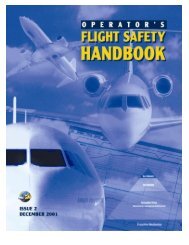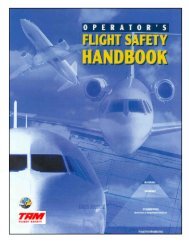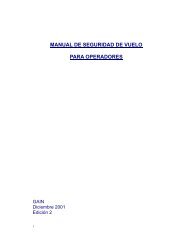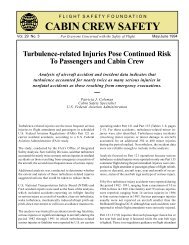Download PDF [10.9 MB] - Flight Safety Foundation
Download PDF [10.9 MB] - Flight Safety Foundation
Download PDF [10.9 MB] - Flight Safety Foundation
Create successful ePaper yourself
Turn your PDF publications into a flip-book with our unique Google optimized e-Paper software.
ONRECORD<br />
“After touchdown, the copilot … discovered<br />
that the brakes did not work, and the airplane<br />
began skidding when he pulled the emergency<br />
parking brake handle,” the report said. “The<br />
airplane was moving about 50 to 60 kt when<br />
both tires blew.”<br />
The airplane veered about 120 degrees left,<br />
skidded off the left side of the runway and came<br />
to a stop after the right main landing gear collapsed<br />
in soft ground. The pilots, alone in the<br />
airplane, were not injured.<br />
“A post-accident examination of the brake<br />
control unit (BCU) revealed a fault on the<br />
printed circuit board that led to an open circuit<br />
for a component installed on the board,” the<br />
report said. “The open circuit caused the failure<br />
of the BCU and the loss of normal braking.”<br />
Collision With a Tug<br />
Airbus A300-B4. Substantial damage. No injuries.<br />
The scheduled cargo flight from East Midlands<br />
Airport in Derby, England, to Paris, the afternoon<br />
of April 14, 2012, also was to serve as a<br />
training flight. The captain-in- training was to fly<br />
the A300 from the left seat, under the supervision<br />
of the training captain/commander in the right<br />
seat, the AAIB report said.<br />
After receiving ATC clearance to start the<br />
engines, the PF used the flight interphone to<br />
advise the ground crew headset operator that<br />
the aircraft was ready to be pushed back from<br />
the stand. During the pushback, the flight crew<br />
started the no. 2 engine.<br />
When the headset operator advised the<br />
flight crew that the pushback was complete, the<br />
PF engaged the aircraft’s parking brake. “The<br />
headset operator then stood by while the no. 1<br />
engine was started,” the report said. “When both<br />
TURBOPROPS<br />
Power Lever Jams<br />
Piaggio P180 Avanti. Substantial damage. Four minor injuries.<br />
The Avanti was climbing through 22,000 ft<br />
during a fractional ownership flight from<br />
Detroit, Michigan, U.S., to West Bend,<br />
engines were running, the PF told the headset<br />
operator to disconnect the tug and that he<br />
would look for his hand signals on the left side<br />
of the aircraft.”<br />
The headset operator was unable to remove<br />
the pin securing the tow bar to the tug and<br />
asked the tug driver for assistance. “Between<br />
them, they withdrew the pin and disconnected<br />
the tow bar from the tug,” the report said. “The<br />
headset operator then disconnected the tow bar<br />
from the aircraft, turned his back on the aircraft<br />
and started to push the tow bar to an area<br />
forward of the aircraft, to reconnect it to the<br />
rear of the tug. At the same time, the tug driver<br />
reversed the tug away from the aircraft before<br />
driving forward to pick up the tow bar.”<br />
Meanwhile, the flight crew completed the<br />
“After Start” checklist, and the PF asked the<br />
commander to request taxi clearance from ATC.<br />
After taxi clearance was received, the PF illuminated<br />
the taxi light and, without receiving the<br />
appropriate hand signal from the ground crew,<br />
increased thrust to begin taxiing. “It is likely<br />
that the tug and ground crew were not visible to<br />
the pilots when the aircraft started to taxi,” the<br />
report said.<br />
The headset operator said that he felt the<br />
aircraft looming above him. He pushed the tow<br />
bar clear of the A300’s nosewheels and watched<br />
the aircraft pass in front of him. The tug driver<br />
saw the aircraft moving and attempted unsuccessfully<br />
to drive clear. The aircraft struck the<br />
left rear side of the tug and pushed it a short<br />
distance before coming to a stop.<br />
The collision caused substantial damage to<br />
the A300’s nose landing gear and minor damage<br />
to the tug, but none of the flight crewmembers<br />
or ground crew was hurt.<br />
Wisconsin, the morning of Nov. 16, 2011,<br />
when the flight crew noticed that the torque<br />
indication for the left engine had decreased<br />
to 94 percent. When the captain attempted<br />
to move the power lever forward, he felt<br />
56 | FLIGHT SAFETY FOUNDATION | AEROSAFETYWORLD | MAY 2013


![Download PDF [10.9 MB] - Flight Safety Foundation](https://img.yumpu.com/18550968/58/500x640/download-pdf-109-mb-flight-safety-foundation.jpg)

![Download this Issue [PDF 7 MB] - Flight Safety Foundation](https://img.yumpu.com/18859635/1/190x245/download-this-issue-pdf-7-mb-flight-safety-foundation.jpg?quality=85)
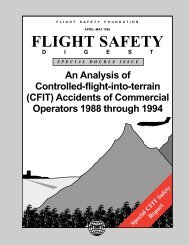
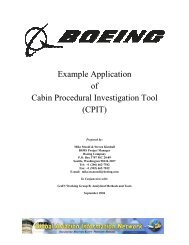
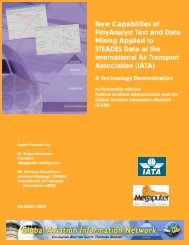
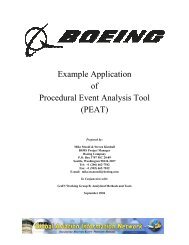
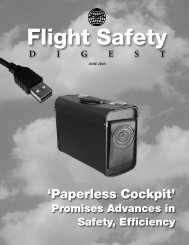
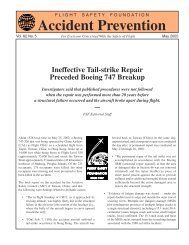
![Download [PDF 8 MB] - Flight Safety Foundation](https://img.yumpu.com/18859366/1/190x245/download-pdf-8-mb-flight-safety-foundation.jpg?quality=85)
